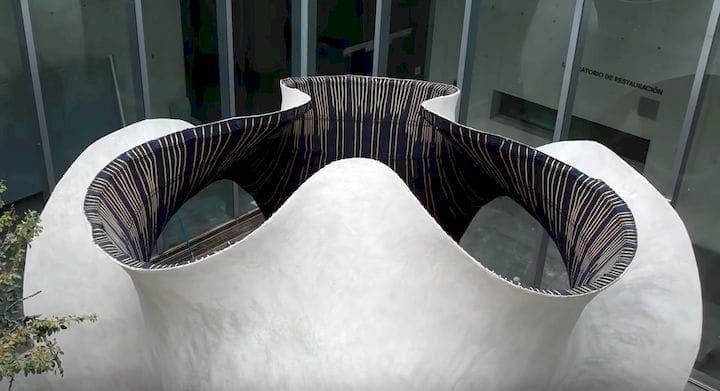![KnitCandela, a concrete structure made with a 3D fabric [Source: ETH Zurich]](https://fabbaloo.com/wp-content/uploads/2020/05/image-asset_img_5eb0a27fb03e5.jpg)
I’m seeing an increasing number of media stories talking about 3D knitting.
This is an unusual process, as traditional fabric preparation involves transforming a 3D design into 2D cuts, as fabric is by definition a 2D material. The 2D pieces are then sewn together and the alignment and 2D curves of the pieces develop the desired 3D structure.
A simple example of this would be to cut a rectangle and wrap it around to touch itself. Sew the adjoining edges together and you have a sleeve. This has transformed a 2D object into a 3D object.
But today’s technology has been applied to this media, just as it is being done in many disciplines. The result is a kind of 3D knitting technology, one of which has been recently used by researchers at ETH Zurich to produce a permanent concrete 3D structure, called “KnitCandela”.
The researchers designed a very complex and large structure, and then matched a 2D surface to it. This 2D surface was produced on a sophisticated knitting device that automatically computes the small 2D pieces and sews them together. The result was a large complex 3D fabric.
Then they did something interesting:
The fabric’s design included slots for support structures. This enabled them to “erect” the full 3D shape of the fabric. While it was temporarily supported, they then applied a spray-style concrete mix to its surface, creating a permanent concrete structure of the same shape.
![Applying concrete to a 3D fabric used as formworks [Source: ETH Zurich]](https://fabbaloo.com/wp-content/uploads/2020/05/image-asset_img_5eb0a2801c0c6.jpg)
In other words, they created a 3D mold from fabric and then cast a structure with it.
This is very similar to approaches used with 3D printing, in which a 3D mold shape is produced and then filled with the final material. This is a very interesting and likely useful process. In fact, the researchers reported that their 50ton concrete structure required only 55kg of formwork during construction.
What’s bothering me is the terminology here. Is this approach “3D printing”, as some media outlets suggest? Or is it something else? Is “3D knitting” a thing?
Sometimes it seems that the public has become so enamored of the phrase “3D printing” that they apply it to any making technology. This is a bit of a switch, as I recall the days when old-timers were calling early 3D printers “mills”, as if they were a kind of CNC machine. Well, I guess they are, but still.
We should simply acknowledge there are many making techniques, and this is another one.
Via ETH Zurich











A research thesis details the incredibly complex world of volumetric 3D printing. We review the highlights.